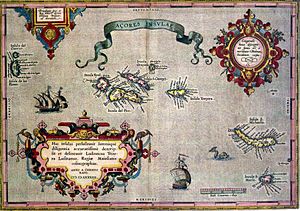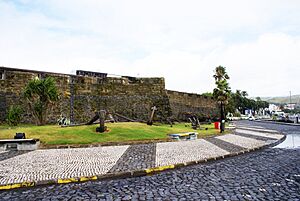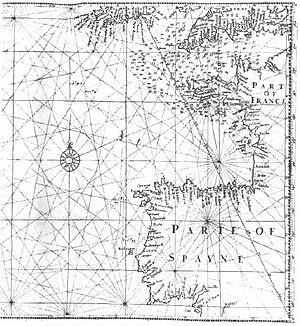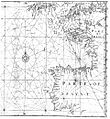Azores Voyage of 1589 facts for kids
Quick facts for kids Azores Voyage of 1589 |
|||||||
|---|---|---|---|---|---|---|---|
| Part of the Anglo–Spanish War | |||||||
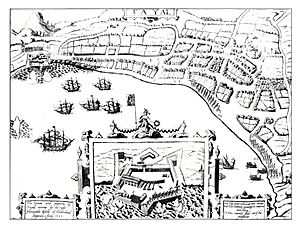 Print of Cumberland' successful attack at Faial island in 1589 |
|||||||
|
|||||||
| Belligerents | |||||||
| Commanders and leaders | |||||||
| Diego Gomez Gaspar de Lemos Faria |
Earl of Cumberland William Monson |
||||||
| Strength | |||||||
| Various Spanish & Portuguese ships, fortifications |
6 warships 300 soldiers |
||||||
| Casualties and losses | |||||||
| 1 galleon sunk 13 ships captured, burnt, sunk, or wrecked 400 killed, wounded, or captured |
40 casualties 100 to disease & thirst |
||||||
The Azores Voyage of 1589 was a series of attacks on the Azores islands by an English expedition. It happened between August and September 1589 during the Anglo–Spanish War. The expedition was led by George Clifford, 3rd Earl of Cumberland.
The English ships attacked different islands to get supplies or capture Spanish and Portuguese ships. They seized many ships and even fought a battle at Faial. There, they captured the main town, which was then looted and burned. The English returned home safely with thirteen captured ships. This trip was a success and made good money for the people who invested in it. However, many sailors died from sickness and storms.
This journey was also important for science. A famous mathematician and mapmaker named Edward Wright joined the trip. He studied how to navigate ships and, for the first time, explained the math behind the Mercator projection map.
Contents
Why the English Sailed to the Azores
At this time, Spain and Portugal were united under one king. This meant that an old peace treaty between England and Portugal was no longer active. Since England and Spain were at war, Portuguese ships became fair targets for the English navy.
The Azores and Cape Verde islands were important places for Spanish treasure ships. These ships would stop there to get food and water before sailing to Spain. This made the islands a good target for English attacks.
Queen Elizabeth I allowed George Clifford, the Earl of Cumberland, to lead a private expedition to the Azores. He gathered several ships, including the Victory, Meg, and Margaret. William Monson, who was only 20 years old, was second in command. Cumberland's fleet left Plymouth on June 18, 1589, and headed towards the coast of Spain.
The Journey and First Captures
As Cumberland's ships approached the Spanish coast, they captured several French and Flemish ships. These ships were carrying fish from Newfoundland, worth a lot of money, and were headed to Lisbon.
Cumberland continued his journey and reached the Azores islands on August 1. His ships waited there, hoping to intercept Spanish treasure ships coming from America. After a few days, Cumberland decided to attack the islands themselves for supplies and any ships anchored there.
Surprise at São Miguel
Cumberland's first stop was at São Miguel. He used a clever trick: he flew a Spanish flag to fool the local forces. He then sailed to the capital, Ponta Delgada. There, he surprised and captured four small Portuguese ships right offshore. These ships were full of olive oil, Madeira wine, wool, silk, and taffeta.
Getting Supplies at Flores
On August 14, the fleet stopped at Flores to get water and food. While there, they learned that some Spanish and Portuguese ships were anchored at Terceira Island. After quickly repairing their ships and gathering supplies without trouble, the English immediately sailed for Terceira.
Battle at Terceira Island
When he arrived, Cumberland sailed into Angra Bay. He spotted, trapped, and immediately attacked the Spanish and Portuguese ships. Another English ship, the Barke of Lyme, joined the fight. It was one of Sir Walter Raleigh's vessels.
Under fire from the fort's cannons, Cumberland's men attacked seven ships. The largest was a Spanish galleon. A running battle began, but as the galleon tried to escape, English gunfire damaged it so much that it sank. It carried pearls, silver, and 200,000 golden ducats.
An attempt to capture a large, heavily armed Portuguese ship failed, and it managed to escape. However, another Portuguese ship from Malacca and India was captured after English sailors boarded it. In total, seven ships were captured. These included Spanish ships like the Nuestra Señora del Loreto and the San Juan, coming from Spanish America. Their valuable cargo included silk, gold, silver, and porcelain. From two Portuguese ships, Cumberland took elephant teeth, grain, coconuts, and Guinean goat skins.
While the battle raged, English prisoners on the island managed to escape. They stole a small boat and were rescued by the Margaret. After capturing and destroying the ships, the English fleet got more water around the island. Then they sailed to Faial Island.
Taking Over Faial Island
On September 6, 1589, the English fleet arrived off Horta harbour in Faial. They approached the Forte de Santa Cruz, which controlled the harbour, under a truce flag. They demanded that the fort surrender, but the Governor refused, saying he was loyal to King Philip of Spain.
After this, 300 English soldiers landed on Lagoa beach. They attacked the port, then quickly moved into the village. They looted the buildings and forced the people to flee inland. For four days, they stole the belongings of the residents. They also demanded a ransom of 2000 ducats. The local leaders eventually paid this, mostly with silver from the churches, which were also damaged by the English.
When the English attacked the fort, it was defended by fewer than fifty Spanish and Portuguese soldiers. The fort was quickly captured after some resistance. The Governor, Diego Gomez, was given safe passage by Cumberland himself. Fifty-eight iron cannons were captured and taken away. The platform where they stood was torn down, and the buildings inside the fort were burned.
After collecting their loot, the fleet sailed to the nearby island of Graciosa. They planned another attack there. However, the Portuguese villagers immediately showed a flag of truce. They brought out about sixty tons of wine and fresh food to the fleet. After this, the English sailed away from the island. By this time, a Spanish treasure fleet had just entered Terceira, but Cumberland missed them while he was at Graciosa.
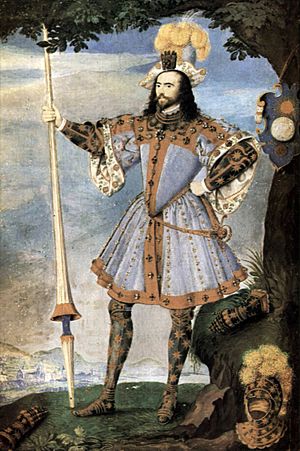
Captures at Santa Maria
The next prize was taken off Santa Maria Island. It was a small Portuguese ship from Portuguese Brazil loaded with sugar. This capture was a tough fight, and the English lost two men and had sixteen others wounded.
Cumberland sent the Margaret, which was too damaged to continue, back to England. It carried the captured ship and many of the wounded sailors. Soon after, Cumberland planned an attack on the island's defenses.
When the English landed in Vila do Porto, they climbed the rocky cliffs of Conceição. They were met with gunfire from the defenders. The Portuguese also threw rocks from the cliffs, causing injuries and confusion among the English. This forced the English to retreat, leaving behind small boats, muskets, and swords. Cumberland himself was wounded in his side, head, and legs, and Captain Lister was shot in the shoulder.
Cumberland's men left to recover from their wounds but were not discouraged. They waited off Santa Maria in their ships. Within a few days, they saw another ship approaching. They quickly captured it. It was a Portuguese vessel of 110 tons, bringing 410 chests of sugar and a large amount of Brazil wood from Brazil.
Based on information from this captured ship, they went after its companion vessel, the Spanish ship Nuestra Señora de Guia. Two days later, the Victory spotted it, caught up, battered it, and then boarded it with help from the Meg. After a short, fierce fight, the Spanish ship surrendered. The English were surprised by what they found: the ship was loaded with animal hides, cochineal (a red dye), some chests of sugar, and also china dishes, plates, and silver.
The remaining English ships then headed for the coast of Spain. The fleet began its journey home, hoping to be back before Christmas with their valuable prizes.
Mapping the Journey
The route of this expedition was used to create the first map by Edward Wright. Wright was a leading English mathematician and cartographer (mapmaker). Elizabeth I asked Wright to join Cumberland's expedition to the Azores to study navigation. One expert called it "the only Fellow of Caius ever to be granted sabbatical leave in order to engage in piracy".
In 1599, ten years after the trip, Wright published the first world map made in England. It was also the first map to use the Mercator projection since Gerardus Mercator's original map from 1569. This map was part of his book called Certaine Errors.
What Happened Next
The expedition was generally successful, and the ships returned to England. However, on the way back, the fleet was hit by severe storms. Many sailors also died from hunger and disease, especially thirst, as water supplies ran out.
After a brief stop in Ireland for supplies due to strong winds, news reached them that an English ship, the Margaret, carrying the richest prize, Nuestra Señora de Guia, had been shipwrecked off the coast of Cornwall. Captain Lister and almost all the crew drowned. However, most of the valuable goods were saved and kept for them. The remaining ships struggled towards Plymouth in a heavy storm. They couldn't land where they started and instead returned to Falmouth on December 27.
Cumberland had captured thirteen ships of different sizes, bringing in varying amounts of profit. When he reached London, he received family news: his eldest son had died, but a daughter had been born.
On the Azores, the fortresses were repaired and strengthened. However, they still didn't have enough cannons to stop ships from landing soldiers. This was seen again in August 1597 when Walter Raleigh and his men attacked, looted, and burned the village of Horta during the Islands Voyage.
The famous explorer John Davis also took part in this expedition.
Images for kids


